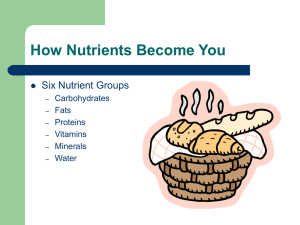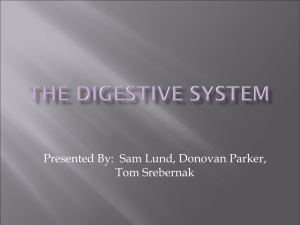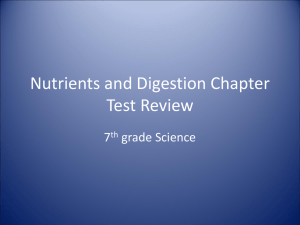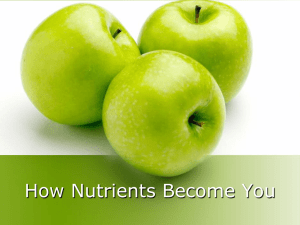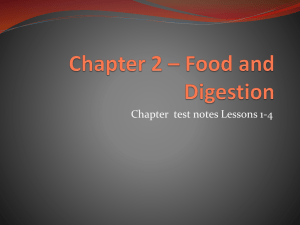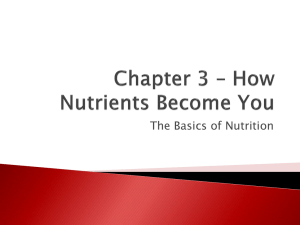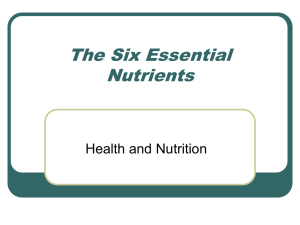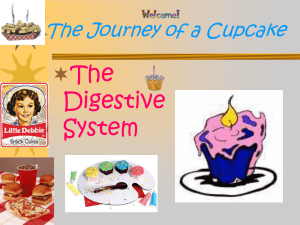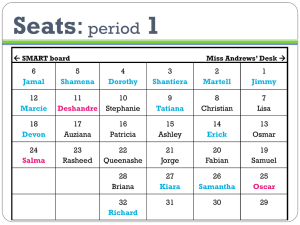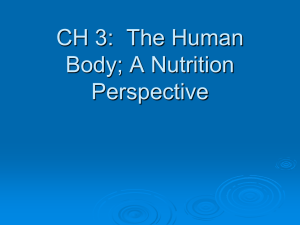How Nutrients Become You
advertisement
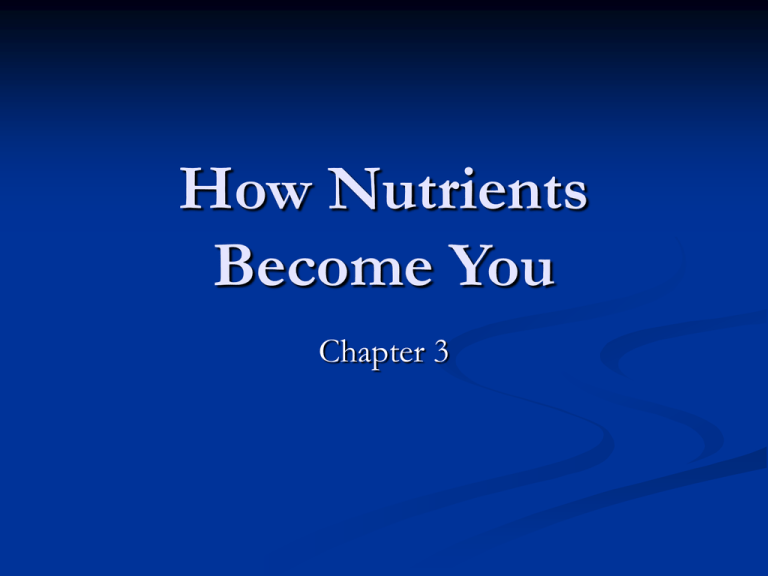
How Nutrients Become You Chapter 3 You Are What You Eat Food is your body’s fuel You need food to function just as a car needs gasoline to function When you eat, your body breaks the food down into nutrients What are Nutrients? Nutrients consist of various chemical substances in food that make up the diet They are essential to life and nourish the body They provide energy and help build and maintain body cells 6 Nutrient Groups Carbohydrates - Energy Fats – Make up cell membranes Proteins – helps make up body cells and helps promote growth Vitamins Minerals Water Functions of Nutrients Build and Repair body tissues Nutrient needs are greater during periods of rapid growth (childhood, adolescence) Lack of adequate nutrition during growth may affect physical size, strength and health Functions of Nutrients Regulate Body Processes Circulation of body fluids, digestions, absorption, and metabolism rely on proper amounts of nutrients Provide Energy Quality of the food you eat will determine how well your body functions Energy is needed for all life processes (breathing, pumping blood, moving muscles) You need energy every minute of the day Carbohydrates, fats are your body’s main source of energy. Protein provides energy in cases of some sicknesses or starvation How is Energy Measured? The energy value of food is measured in kilocalories, also know as calories Carbohydrates provide the body with 4 kilocalories per gram Fats provide 9 kilocalories per gram Proteins provide 4 kilocalories per gram Video: The Digestive System Why is digestions described as both a mechanical and a chemical process? What Happens to the Food I Eat? Digestion occurs. This is the breakdown of food into usable forms we can absorb It starts in the mouth In the Mouth Digestion starts when you see or smell food; saliva can start flowing in the mouth The enzyme salivary amylase in saliva helps break down starches Your teeth physically break down food by grinding it into tiny pieces; known as chewing or mastication Alpha amylase works at an optimal pH of 7 and a body temperature of 98.6. Demo with chalk and cracker The tongue contains taste buds that help us tell the difference between salty, sour, sweet, and bitter foods. In the Esophagus The esophagus is a transportation tube from the mouth to the stomach. When we swallow we are closing a trap door in our throat called the epiglottis. This allows food to go down the esophagus and prevents food from going down the trachea or windpipe into the lungs. Muscles of the esophagus contract and relax forcing the food into the stomach THE LEAST AMOUNT OF DIGESTION OCCURS IN THE ESOPHAGUS Demo rubber tube In the Stomach Stomach is widest part of the digestive system, and is located on the left side of the body-can hold about 2 ½ pints of food Stomach produces gastric juices that chemically break down food The food is moved around in the stomach for 3-4 hours to allow the chemicals to break down the food into a cream-like liquid called chyme. Now a value at the end of the stomach opens and sends the food to the liver. Demo Leaf Digesting Nutrients Liquids leave the stomach before solids Carbohydrates and proteins digest faster than fats This is why fatty foods give you a feeling of fullness At this point, the food is mixed with more chemicals. The liver produces a chemical called bile, which is stored in the gall bladder. When the gall bladder mixes bile with the chyme (our food) it breaks down fat into tiny droplets. Demo oil The pancreas also adds a digestive chemical as the chyme leaves the stomach. This digestive juice works on breaking down carbohydrates and proteins. Small Intestine The small intestines are approximately 18 feet long. As the food passes through it is mixed with new chemicals. At this time it is digested long enough to be used by the body. About 95% of digestion occurs in the small intestine Along the walls of the intestine are thousands of tiny fingers called villi. Blood vessels (capillaries) in the villi can absorb the tiny food molecules and send them through the blood to the rest of the body. Demo- tube with villi, and length of digestive tract. Absorption of Nutrients Passage of nutrients from digestive to circulatory and lymphatic systems Water soluble nutrients Amino acids, monosaccharides, minerals, vitamin C, B vitamins Fat soluble nutrients Vitamins A, D, E, K, fatty acids, glycerol, monoglycerides Absorption of Nutrients Digested food molecules are passed through the wall and into the blood stream and carried to cells throughout the body – This is known as absorption Nutrients are absorbed in the small intestine and the large intestine Once nutrients reach your cells, they undergo changes to produce energy needed to sustain life (metabolism) Large Intestine Whatever the body cannot use is sent to the large intestine where water is removed. Water is necessary up until this point for digestion. Main function is to reabsorb water and send it into the bloodstream. Food will spend about 12 hours in the large intestine. Undigested food is called solid waste feces. This is stored in the rectum until it leaves the body. Vocab to Know for Test 1 Risk factor Physical health Nutrient Ethnic food Status food Digestion Peristalsis mastication Wellness Mental health Social health Culture Food taboo Kilocalorie Metabolism True or False Eating dog is a food taboo in the United States. Stress is an uncontrollable risk factor for heart disease. The most digestion takes place in the esophagus. Fats leave the stomach before liquids. The nutrients carbohydrates, fats and proteins provide your body with energy. Wellness is made up of what 3 types of health? What are the top 3 leading causes of death? What are the 6 nutrients? What are some health risks of obesity? What is the main internal factor that drives us to eat? When do you form your beliefs about food? Know the order of the digestion process What are external factors that drive us to eat? Where does the most digestion take place? Where does the least digestion take place? In what order does food leave the stomach? Which 3 nutrients provide energy? Short Answer Questions (Choose 2) Name the six basic types of nutrients you must obtain from the foods you eat. How can emotions affect your food choices? Explain. What are the three main functions of nutrients? What are two factors that affect individual food preference? What is the main job of the large intestine?
